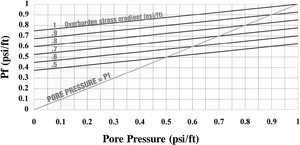Fracture threshold in the real world
We don't really know how high the pore pressure must be to induce fracturing. In field examples, failure seems to occur below the fracture pressure.[1][2][3][4][5] Risk increases as overpressure increases relative to Pf, but failure may occur below the theoretical fracture pressure. Other factors, not yet understood, control the point at which failure occurs.
Theoretically, fracturing occurs when the pore pressure reaches Pf. However, Pf increases as pore pressure increases. Although the theory generally is described in terms of the pore pressure needed to overcome the horizontal stress keeping the fractures closed, in practice the pore pressure must approach the lithostatic pressure for brittle failure to occur.[6]
Figure 1 charts Pf vs. pore pressure for a range of overburden stress gradients (0.5–1.0). The pore pressure equals or exceeds Pf only when the pore pressure is equal to or greater than the lithostatic stress. Fracture occurs when Pf equals the pore pressure.
Stress and poisson's ratio variation
Although the variables used to calculate the fracture pressure commonly are generalized as a smooth curve, there are local variations and departures from this generalized curve. The principal horizontal stress, ε3* and Poisson's ratio depend on lithology and bed geometry as well as depth and compaction.[6]
Pore pressure variations
Pore pressure (p) is not always a smooth curve.[7] Decompaction is controlled in part by the permeability of sediment layers. Shales adjacent to high-permeability layers may undergo rapid decompaction while thick shale sequences with no immediate access to high-permeability layers will decompact more slowly and have high pore pressures. Local variations in pore pressure may be important in evolving seal integrity during basin subsidence.
Effect of water depth, stratigraphy, and facies changes
Pore pressure alone does not control hydraulic fracturing. Changes in the overburden stress change the theoretical fracture pressure and seal risk. For example, water depth alters the overburden stress and therefore Pf. Figure 2 compares the fracture gradient pressure for the case of a well on land and the same well with an additional 298 ft (100 m) of water column. The water column substitutes low-density water for high-density rock. The result is a shift of Pf to lower values. If the water depth were sufficiently great, there would be an increased likelihood of hydraulic fracturing with no change in pore pressure.
Similarly, facies changes within a basin can alter the density distribution in the sediment column and seal risk. A facies change from dense carbonates to less dense siliciclastics changes the overburden stress gradient. A higher pore pressure is required to fracture a top seal in the denser sediment column. Seal risk is greater in the less dense sediment column. The overburden stress gradient and seal risk similarly change with progressive subsidence and compaction.
See also
References
- ↑ Skerlec, G., M., 1982, Risking top seals in the Central Graben: Exxon Production Research Company internal report.
- ↑ Skerlec, G., M., 1990, SEALS: A short course for risking top seal and fault seal: Franklin, Pennsylvania, SEALS International, 600 p.
- ↑ Dutta, N., C., 1987, Fluid flow in low permeability porous media, in Doligez, B., ed., Migration of Hydrocarbons in Sedimentary Basins: Paris, Editions Technip, p. 567–596.
- ↑ Lerche, I., 1990, Basin Analysis I: San Diego, Academic Press, 562 p.
- ↑ Ungerer, P., Burrus, J., Doligez, B., Chenet, P., Y., Bessis, F., 1990, Basin evaluation by integrated two-dimensional modeling of heat transfer, fluid flow, hydrocarbon generation, and migration: AAPG Bulletin, vol. 74, no. 3, p. 309–335.
- ↑ 6.0 6.1 Lorenz, J., C., Teufel, L., W., Warpinski, N., R., 1991, Regional fractures: a mechanism for the formation of regional fractures at depth in flat-lying reservoirs: AAPG Bulletin, vol. 75, no. 11, p. 1714–1737.
- ↑ Engelder, T., Leftwich, J., 1993, An analysis of geopressure profiles from south Texas: the search for higher quality reservoirs in the Tertiary sections of the Gulf Coast: AAPG Hedberg Research conference, unpublished abstract.
